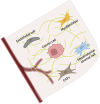In vitro 3D modeling of colorectal cancer: the pivotal role of the extracellular matrix, stroma and immune modulation
- PMID: 40376304
- PMCID: PMC12078225
- DOI: 10.3389/fgene.2025.1545017
In vitro 3D modeling of colorectal cancer: the pivotal role of the extracellular matrix, stroma and immune modulation
Abstract
Colorectal cancer (CRC) is a leading global cancer with high mortality, especially in metastatic cases, with limited therapeutic options. The tumor microenvironment (TME), a network comprising various immune cells, stromal cells and extracellular (ECM) components plays a crucial role in influencing tumor progression and therapy outcome. The genetic heterogeneity of CRC and the complex TME complicates the development of effective, personalized treatment strategies. The prognosis has slowly improved during the past decades, but metastatic CRC (mCRC) is common among patients and is still associated with low survival. The therapeutic options for CRC differ from those for mCRC and include surgery (mostly for CRC), chemotherapy, growth factor receptor signaling pathway targeting, as well as immunotherapy. Malignant CRC cells are established in the TME, which varies depending on the primary or metastatic site. Herein, we review the role and interactions of several ECM components in 3D models of CRC and mCRC tumor cells, with an emphasis on how the TME affects tumor growth and treatment. This comprehensive summary provides support for the development of 3D models that mimic the interactions within the TME, which will be essential for the development of novel anticancer therapies.
Keywords: 3D model; colorectal cancer; extracellular matrix; immune cells; in vitro; therapy; tumor microenvironment.
Copyright © 2025 Hanitrarimalala, Prgomet, Hedhammar, Tassidis and Wingren.
Conflict of interest statement
The authors declare that the research was conducted in the absence of any commercial or financial relationships that could be construed as a potential conflict of interest.
Figures





Similar articles
-
The colorectal cancer microenvironment: Preclinical progress in identifying targets for cancer therapy.Transl Oncol. 2025 Mar;53:102307. doi: 10.1016/j.tranon.2025.102307. Epub 2025 Feb 3. Transl Oncol. 2025. PMID: 39904281 Free PMC article. Review.
-
Differential cellular origins of the extracellular matrix of tumor and normal tissues according to colorectal cancer subtypes.Br J Cancer. 2025 May;132(9):770-782. doi: 10.1038/s41416-025-02964-z. Epub 2025 Mar 3. Br J Cancer. 2025. PMID: 40032993 Free PMC article.
-
Hypoxia reconstructed colorectal tumor microenvironment weakening anti-tumor immunity: construction of a new prognosis predicting model through transcriptome analysis.Front Immunol. 2024 Dec 6;15:1425687. doi: 10.3389/fimmu.2024.1425687. eCollection 2024. Front Immunol. 2024. PMID: 39712012 Free PMC article.
-
Targeting integrin α5 in fibroblasts potentiates colorectal cancer response to PD-L1 blockade by affecting extracellular-matrix deposition.J Immunother Cancer. 2023 Dec 1;11(12):e007447. doi: 10.1136/jitc-2023-007447. J Immunother Cancer. 2023. PMID: 38040421 Free PMC article.
-
Taking a Full Snapshot of Cancer Biology: Deciphering the Tumor Microenvironment for Effective Cancer Therapy in the Oncology Clinic.OMICS. 2020 Apr;24(4):175-179. doi: 10.1089/omi.2020.0019. Epub 2020 Mar 13. OMICS. 2020. PMID: 32176591 Review.
References
Publication types
LinkOut - more resources
Full Text Sources
Other Literature Sources
Miscellaneous

